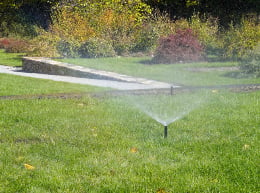
It is certainly frustrating to see thinning or big empty patches in an otherwise smooth, green Kentucky bluegrass seed lawn. Such problems may indicate something beyond usual lawn neglect. Two ways to get your bluegrass seed lawn back to normal is through patching or overseeding.
Before you start either process, however, you need to consider two things: first, is your Kentucky bluegrass lawn looking problematic because you are not mowing, fertilizing, or watering it properly? If so, adjust your lawn care methods and give your lawn the chance to regenerate. Second, if you are providing your bluegrass lawn adequate care, what is the source of these problem areas? Is it an overbearing shade tree, an unbalanced sprinkler system, weeds cropping up in certain areas, or disease? Ascertain what the problem is and make sure it’s fixed before you try to repair your Kentucky bluegrass seed lawn. Otherwise you’ll have a continual cycle of reseeding and patching that will only work temporarily.
Here are some suggestions for each of the methods.- Patching
- For every deadening patch, dig up the damaged area about 6 inches around it and 2 inches deep. Get rid of all the dead plants until you have just soil. Continue digging in the soil to loosen it and remove any more plant fragments.
- If the soil is not the right consistency (too much clay or too sandy), try adding some appropriate organic soil amendments to improve the drainage and fertility. Work the amendments well into the soil.
- If necessary, apply a starter fertilizer to the soil and lightly water.
- Plant your bluegrass seeds in early spring or late summer, when the temperatures are cool enough for germination to occur.
- If you are planting grass seeds, sow more than you usually would for a bare area, and cover the area with soil, and firm the topsoil with a rake. If you are laying sod, cut the piece to fit the patch.
- Cover the newly planted grass seeds lightly with mulch, if appropriate.
- Lightly water the area until germination occurs, or until the sod is deeply rooted.
- Overseeding
- It is as important to prepare the area of your bluegrass lawn for overseeding as it is for planting. Pull out any weeds, get rid of thatch, aerate the soil, and fertilize if necessary. Give the Kentucky bluegrass seeds the best possible opportunity to germinate, grow, and fill out your yard.
 Make sure that you plant your Kentucky bluegrass seeds in early spring or late summer in order to give the seeds the best possible chance of germination and permanent establishment.
Make sure that you plant your Kentucky bluegrass seeds in early spring or late summer in order to give the seeds the best possible chance of germination and permanent establishment.- Consider overseeding with a different grass species to help strengthen your lawn and make it more adaptable to a variety of conditions.
- Water your bluegrass seed lawn lightly and frequently, keeping it moist until the bluegrass seeds germinate. Continue watering on a regular schedule as the Kentucky bluegrass seeds grow in.
- Try not to walk on your newly germinated lawn for 1–3 weeks to prevent damaging any new seedlings.
- Be sure to consult our other Kentucky bluegrass guides for information on watering, fertilization and mowing techniques.
